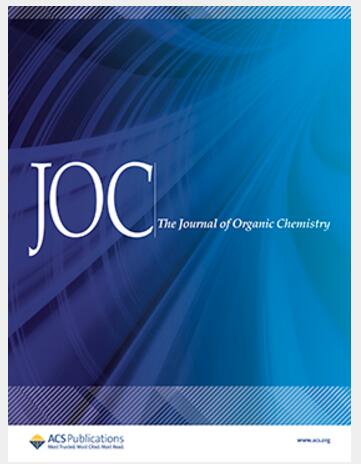镍和光氧化催化的不对称还原交叉偶联获得手性仲苄基醇。
IF 3.6
2区 化学
Q1 CHEMISTRY, ORGANIC
Journal of Organic Chemistry
Pub Date : 2024-11-15
Epub Date: 2024-02-07
DOI:10.1021/acs.joc.3c02293
引用次数: 0
摘要
过渡金属催化的不对称交叉偶联是 C-C 键形成和合成对映体纯分子的有力策略。在此,我们报告了一种镍/光氧化物双催化的芳基卤化物与α-溴苯甲酸酯的对映选择性还原交叉偶联反应,这种反应很容易从脂肪族醛中生成,可提供多种手性仲苄醇,而这些仲苄醇是生物活性天然产物和药物中的重要基团。这种双催化系统的特点是条件温和、官能团耐受性好、底物范围广、对映控制出色,而且无需使用化学计量金属还原剂,为复杂分子的后期官能化提供了巨大潜力。本文章由计算机程序翻译,如有差异,请以英文原文为准。
Dual Nickel- and Photoredox-Catalyzed Asymmetric Reductive Cross-Coupling To Access Chiral Secondary Benzylic Alcohols.
Transition-metal-catalyzed asymmetric cross-coupling represents a powerful strategy for C-C bond formation and the synthesis of enantiomerically pure molecules. Here, we report a dual nickel/photoredox-catalyzed enantioselective reductive cross-coupling of aryl halides with α-bromobenzoates, readily generated from aliphatic aldehydes, to provide diverse chiral secondary benzylic alcohols that are important motifs in bioactive natural products and pharmaceuticals. This dual catalytic system features mild conditions, good functional group tolerance, broad substrate scope, excellent enantiocontrol, and avoidance of stoichiometric metal reductants, presenting great potential for late-stage functionalization of complex molecules.
求助全文
通过发布文献求助,成功后即可免费获取论文全文。
去求助
来源期刊

Journal of Organic Chemistry
化学-有机化学
CiteScore
6.20
自引率
11.10%
发文量
1467
审稿时长
2 months
期刊介绍:
Journal of Organic Chemistry welcomes original contributions of fundamental research in all branches of the theory and practice of organic chemistry. In selecting manuscripts for publication, the editors place emphasis on the quality and novelty of the work, as well as the breadth of interest to the organic chemistry community.
 求助内容:
求助内容: 应助结果提醒方式:
应助结果提醒方式:


